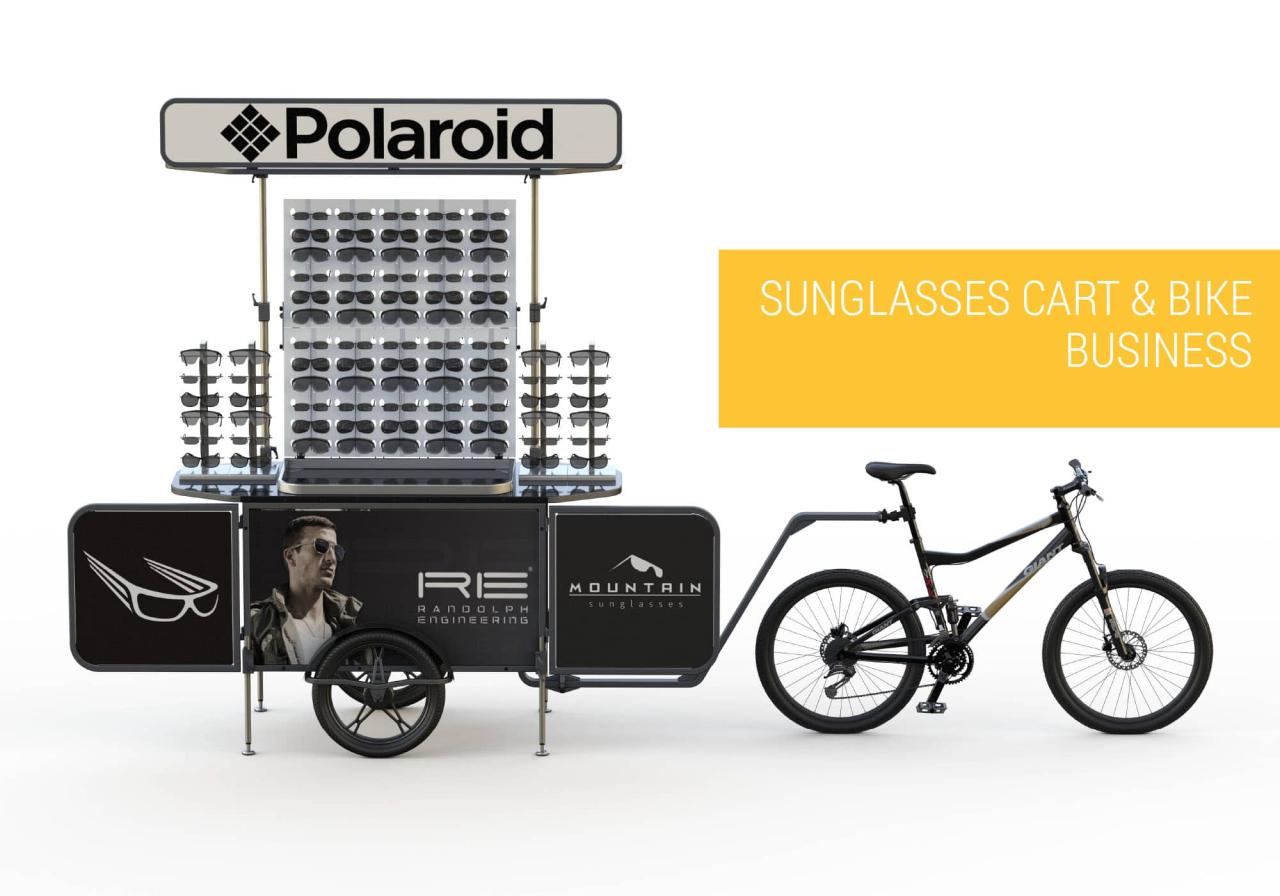How to start a sunglasses business? It’s a question brimming with potential, blending style, entrepreneurship, and a touch of sun-drenched ambition. This guide navigates the exciting journey from initial market research to establishing a thriving brand, covering everything from product development and sourcing to marketing strategies and legal considerations. We’ll explore the intricacies of designing unique sunglass styles, securing funding, and building a robust online presence, equipping you with the knowledge to turn your vision into a successful reality.
Launching a sunglasses business requires a multifaceted approach. Thorough market research is paramount, identifying your target demographics and analyzing competitor strategies. Subsequently, crafting a unique brand identity, sourcing high-quality materials, and implementing effective marketing campaigns are crucial for success. Finally, understanding the legal and financial aspects, from licensing to securing funding, will ensure a sustainable and profitable enterprise.
Market Research & Analysis
Thorough market research is crucial for launching a successful sunglasses business. Understanding consumer demographics, competitive pricing, current trends, and market projections allows for informed strategic decision-making, maximizing the chances of profitability and market penetration. This section will delve into these key areas to provide a foundational understanding of the sunglasses market.
Key Demographics and Purchasing Habits
Three key demographics significantly impact the sunglasses market: young adults (18-35), middle-aged professionals (35-55), and senior citizens (55+). Young adults are often driven by trends and fashion, prioritizing stylish designs and affordability. Their purchasing habits frequently involve online shopping and brand loyalty influenced by social media marketing. Middle-aged professionals tend to value quality, durability, and brand reputation, often seeking sunglasses that complement their professional image. Their purchasing habits are less impulsive, with a focus on long-term value and potential investment in higher-priced brands. Senior citizens prioritize comfort, UV protection, and ease of use. Their purchasing habits are often influenced by recommendations from friends and family, and they might be more inclined to purchase from brick-and-mortar stores.
Competitive Pricing Strategies
Analyzing the pricing strategies of major competitors like Luxottica (owner of Ray-Ban, Oakley, etc.), Safilo Group, and EssilorLuxottica provides valuable insights. Luxottica employs a premium pricing strategy, leveraging strong brand recognition and high-quality materials to justify higher prices. Safilo Group utilizes a tiered pricing approach, offering a range of products catering to different price sensitivities, from budget-friendly options to more expensive designer lines. EssilorLuxottica, a dominant player, employs a strategy that balances premium pricing for flagship brands with more affordable options under different labels, effectively capturing a broad market segment.
Current Trends in Sunglass Design and Materials
Current trends in sunglass design showcase a blend of classic styles with modern innovations. Oversized sunglasses, particularly square and cat-eye shapes, remain popular, while retro-inspired designs continue to experience a resurgence. Bio-acetate and sustainable materials are gaining traction, aligning with growing consumer demand for eco-friendly products. Additionally, technological advancements are influencing sunglass design, with features like photochromic lenses (automatically adjusting to light conditions) and polarized lenses (reducing glare) becoming increasingly prevalent. Smart glasses, integrating technology into the frames, represent a niche but growing segment.
Projected Market Size and Growth
The following table projects the sunglasses market size and growth over the next five years. These projections are based on current market trends, projected economic growth, and industry reports, and should be considered estimates. Actual figures may vary depending on various economic and social factors. For example, a significant global recession could negatively impact sales, while a surge in outdoor activities could lead to higher-than-projected growth.
| Year | Projected Sales (USD Billion) | Growth Rate (%) | Market Share (Example Brand X) |
|---|---|---|---|
| 2024 | 15.5 | 4.2 | 12% |
| 2025 | 16.1 | 3.9 | 12.5% |
| 2026 | 16.8 | 4.3 | 13% |
| 2027 | 17.5 | 4.2 | 13.5% |
| 2028 | 18.3 | 4.6 | 14% |
Product Development & Sourcing

Developing and sourcing your sunglasses line requires careful planning and execution. This involves designing appealing styles, choosing appropriate materials, and deciding on a manufacturing strategy that balances cost, quality, and ethical considerations. The following sections Artikel key steps in this crucial phase of launching your sunglasses business.
Sunglass Style Designs
Three distinct sunglass styles, each targeting a different demographic, are Artikeld below. Effective product development considers diverse consumer preferences and market segments to maximize reach and sales.
- Style 1: The “Urban Edge” – Target audience: Young adults (18-35), fashion-conscious, urban dwellers. Materials: Lightweight, high-impact polycarbonate frames in matte black or tortoise shell. Polarized lenses in a gradient grey or amber. Design features: Sleek, angular frame shape, subtle branding, and a comfortable fit. This style prioritizes modern aesthetics and durability.
- Style 2: The “Classic Aviator” – Target audience: Professionals (35-55), value quality and timeless design. Materials: High-quality acetate frames in classic colors like black, brown, or Havana. CR-39 lenses with UV protection. Design features: The iconic aviator shape with subtle variations, metal accents, and a durable hinge mechanism. This style emphasizes sophistication and longevity.
- Style 3: The “Active Sport” – Target audience: Athletes and outdoor enthusiasts (25-45). Materials: Flexible, durable TR90 frames in bright, energetic colors (e.g., blue, green, orange). Impact-resistant polycarbonate lenses with anti-fog and hydrophobic coatings. Design features: Wrap-around style for superior protection, adjustable nose pads, and comfortable temple arms. This style focuses on functionality and performance.
Domestic vs. Overseas Manufacturing
The decision of where to manufacture your sunglasses involves weighing various factors. Domestic production offers advantages such as greater quality control and shorter lead times, but comes with higher labor and material costs. Overseas manufacturing, typically in countries like China or Vietnam, provides lower production costs, but may present challenges with quality control, lead times, and ethical concerns.
| Factor | Domestic Manufacturing | Overseas Manufacturing |
|---|---|---|
| Cost | Higher | Lower |
| Quality Control | Easier to maintain | More challenging |
| Lead Times | Shorter | Longer |
| Transportation Costs | Lower | Higher |
| Ethical Considerations | Easier to monitor | Requires diligent oversight |
Legal and Ethical Sourcing Considerations
Sourcing materials and manufacturing sunglasses ethically and legally is paramount. This involves ensuring compliance with labor laws, environmental regulations, and intellectual property rights. Due diligence in selecting suppliers and manufacturing partners is essential. This includes verifying their compliance with relevant international standards and conducting regular audits. For example, ensuring your suppliers adhere to fair labor practices, such as paying fair wages and providing safe working conditions, is crucial for maintaining a positive brand image and avoiding legal repercussions.
Sunglass Prototype Creation
Creating a sample prototype is a crucial step in the product development process. This allows you to assess the design, functionality, and overall quality before mass production.
- Design Finalization: Refine the chosen sunglass design based on initial sketches and market research.
- Material Selection: Select the final materials for the frames and lenses, considering factors such as durability, cost, and aesthetics.
- Supplier Selection: Identify and select a prototyping service or manufacturer that meets your quality and ethical standards.
- Prototype Production: Submit the finalized design and material specifications to the chosen supplier for prototype creation.
- Review and Iteration: Once the prototype is received, carefully review it for any design flaws or necessary adjustments. Iterate on the design as needed before proceeding to mass production.
Branding & Marketing: How To Start A Sunglasses Business

A strong brand and effective marketing are crucial for launching a successful sunglasses business. Your brand identity needs to resonate with your target audience, clearly communicating the value proposition of your sunglasses. Simultaneously, a well-executed marketing strategy will ensure your brand reaches the right consumers and drives sales.
Building a compelling brand involves more than just a catchy name; it’s about creating a holistic identity that encapsulates your brand’s personality, values, and unique selling proposition. This identity then informs all aspects of your business, from product design to marketing materials. A cohesive brand strategy increases customer recognition and loyalty, leading to higher sales and brand equity.
Brand Name and Logo Development
Developing a memorable and relevant brand name and logo is paramount. The name should be easy to pronounce, remember, and ideally, reflect the style and quality of your sunglasses. For instance, a brand targeting a younger, trend-conscious audience might choose a name that is short, modern, and slightly edgy, while a brand focused on luxury might opt for a more sophisticated and classic name. The logo should visually represent the brand’s personality and values. Consider the following example: A brand focused on sustainable and eco-friendly sunglasses might use a logo incorporating natural elements like leaves or a sun graphic made from recycled materials, represented in muted earth tones. Conversely, a brand aiming for a bold and modern image could feature a geometric logo with sharp lines and vibrant colors. A possible logo design could be a stylized sun icon, with the rays subtly forming the shape of sunglasses, incorporated into a minimalist, modern font for the brand name. The color palette could use a combination of deep blues and bright golds to evoke feelings of luxury and warmth.
Effective Online Marketing Strategies
Reaching the target audience online requires a multi-pronged approach. Three highly effective strategies include: Search Engine Optimization (), paid advertising (PPC), and social media marketing. involves optimizing your website and content to rank higher in search engine results for relevant s (e.g., “best polarized sunglasses,” “women’s designer sunglasses”). PPC, or pay-per-click advertising, allows you to run targeted ads on platforms like Google Ads and social media, reaching specific demographics based on interests and behaviors. Social media marketing leverages platforms like Instagram, Facebook, and TikTok to build brand awareness, engage with potential customers, and drive traffic to your website.
Social Media Marketing Plan
A comprehensive social media marketing plan should detail content strategy, posting schedule, and engagement tactics. For example, a plan might focus on Instagram, given its visual nature and popularity with fashion-conscious consumers. Content could include high-quality images and videos showcasing the sunglasses in various settings and on different models. The posting schedule could involve daily or multiple times a week posts, maintaining consistency to keep the audience engaged. Engagement tactics should include responding to comments and messages promptly, running contests and giveaways, and collaborating with relevant influencers. Analyzing social media analytics to track performance and adapt the strategy accordingly is crucial for success.
Advantages and Disadvantages of Influencer Marketing
Influencer marketing, utilizing social media personalities to promote your sunglasses, offers significant advantages. It can increase brand awareness, reach a wider audience, and build trust and credibility through association with a trusted influencer. However, it also presents disadvantages. It can be expensive, especially if you choose high-profile influencers. There’s also a risk of negative associations if the influencer’s reputation suffers or their audience doesn’t align with your target market. Carefully vetting influencers and setting clear expectations are vital to mitigate these risks. For example, partnering with micro-influencers (those with smaller, highly engaged followings) can be a cost-effective alternative to working with macro-influencers.
Sales & Distribution

Successfully launching a sunglasses business requires a robust sales and distribution strategy. This involves selecting appropriate channels to reach your target market, implementing a competitive pricing model, and establishing a reliable customer service system. A well-designed e-commerce presence is also crucial for maximizing online sales.
Sales Channels for Sunglasses, How to start a sunglasses business
Choosing the right sales channels is vital for reaching your target audience and maximizing revenue. A multi-channel approach often proves most effective.
- Online Store: An e-commerce website provides direct control over branding, pricing, and customer interaction. It allows for global reach and 24/7 availability. Effective and targeted advertising are essential for driving traffic to the site.
- Retail Partnerships: Collaborating with established retailers (boutiques, department stores, optical shops) expands your reach to their existing customer base. This strategy requires negotiating favorable terms, managing inventory, and potentially sharing profits. Partnerships with complementary brands can also create synergistic opportunities.
- Wholesale: Selling in bulk to wholesalers or distributors allows for larger sales volumes but typically results in lower profit margins per unit. This approach is suitable for established brands with strong production capacity and a well-defined distribution network. Careful selection of wholesalers is crucial to ensure they align with your brand values and target market.
Pricing Strategy for Sunglasses
A well-defined pricing strategy balances profitability with market competitiveness. It’s crucial to consider production costs, competitor pricing, and perceived value.
Several pricing models can be applied. Cost-plus pricing adds a markup percentage to the production cost to determine the selling price. Value-based pricing sets prices based on the perceived value of the product to the customer, often higher than cost-plus. Competitive pricing involves aligning prices with those of similar products in the market. A combination of these models is often employed. For example, a new brand might use competitive pricing initially to gain market share, then transition to value-based pricing as brand recognition increases.
The ideal pricing strategy maximizes profit while remaining competitive and appealing to the target customer.
Customer Service Plan
Exceptional customer service fosters loyalty and positive brand perception. A clear plan for handling returns, exchanges, and inquiries is essential.
This plan should include detailed procedures for processing returns and exchanges, clearly outlining eligibility criteria, timelines, and refund methods. It should also specify how customer inquiries will be handled, whether through email, phone, or a live chat feature on the website. Prompt and professional responses to customer concerns are crucial for maintaining satisfaction. Consider implementing a system for tracking customer interactions and resolving issues efficiently. A well-structured FAQ section on the website can also proactively address common questions.
E-commerce Website Design
A user-friendly and professional e-commerce website is crucial for online success. It should be visually appealing, easy to navigate, and optimized for conversions.
Key features include high-quality product photography, detailed product descriptions, secure payment gateways, and a streamlined checkout process. Mobile responsiveness is essential for reaching customers on various devices. Integrating social media features can enhance engagement. Consider using a platform like Shopify or WooCommerce to simplify the website building process. Regular website maintenance and updates are crucial for maintaining performance and security. A well-designed website should load quickly, be visually appealing, and provide a seamless user experience from browsing to purchase.
Legal & Financial Aspects
Launching a sunglass business requires navigating both legal and financial landscapes. Understanding the regulatory requirements and securing sufficient funding are crucial for success. Failure to address these aspects thoroughly can lead to significant challenges down the line, impacting profitability and even the viability of the business.
Necessary Licenses and Permits
The specific licenses and permits needed to operate a sunglass business vary significantly depending on your location (city, state, and country). Generally, you’ll need a business license, which is usually obtained at the local or state level. Depending on your business structure (sole proprietorship, LLC, etc.), additional registrations may be required. If you manufacture your sunglasses, you may need manufacturing permits and potentially licenses related to product safety and compliance with industry standards. Furthermore, if you plan to sell your sunglasses online, you may need to register with relevant e-commerce platforms and comply with their terms of service and data protection regulations. Always check with your local government agencies and relevant regulatory bodies to obtain a complete list of necessary permits and licenses. Failing to obtain the proper permits can result in hefty fines and legal repercussions.
Securing Funding for Your Sunglass Business
Funding your sunglass business can involve several strategies. Small business loans from banks or credit unions are a common option. These typically require a detailed business plan, demonstrating financial viability and repayment capacity. Alternatively, you could explore seeking investment from angel investors or venture capitalists, though this usually requires a strong business model with significant growth potential. Crowdfunding platforms offer another avenue, allowing you to raise capital from a large number of individuals who believe in your product. Finally, bootstrapping, using your personal savings or revenue generated from the business itself, is a viable, albeit often slower, option. The best funding strategy depends on your risk tolerance, the stage of your business, and the amount of capital required. For example, a startup might rely on bootstrapping and loans initially, while a rapidly scaling business could seek venture capital.
Sample Business Plan
A comprehensive business plan is essential for securing funding and guiding your business decisions. It should include an executive summary outlining your business concept and goals; a market analysis detailing your target market, competition, and market trends; a marketing and sales strategy; a detailed description of your products and sourcing; and crucially, financial projections including start-up costs, revenue forecasts, and profit margins. For example, your financial projections might forecast sales of 10,000 units in the first year, increasing to 25,000 units in year three, based on market research and sales projections. A realistic and well-researched business plan increases your chances of securing funding and provides a roadmap for your business’s growth. Many online resources and small business development centers offer templates and guidance on creating a comprehensive business plan.
Inventory and Cash Flow Management
Effective inventory and cash flow management are vital for the financial health of your sunglass business. Inventory management involves strategically ordering and storing sunglasses to meet demand while minimizing storage costs and avoiding stockouts or excess inventory. This might involve utilizing forecasting techniques to predict demand and implementing just-in-time inventory management to minimize storage costs. Cash flow management focuses on monitoring and controlling the inflow and outflow of cash. This requires careful tracking of expenses, timely invoicing, and potentially securing lines of credit to manage short-term cash flow fluctuations. For instance, you might establish a system for tracking payments from wholesalers, creating a realistic budget that accounts for seasonal sales fluctuations, and securing a small business line of credit as a buffer for unexpected expenses. Robust inventory and cash flow management practices ensure your business remains financially stable and can react effectively to changing market conditions.






